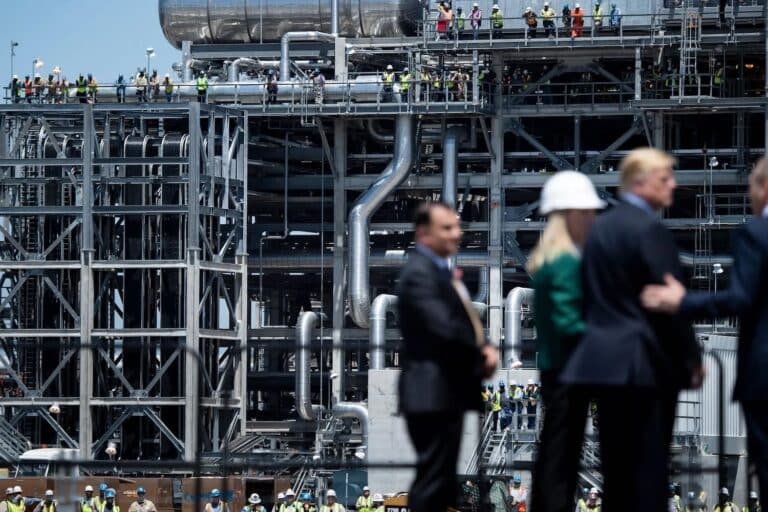China Halts U.S. LNG Imports Amid Tariff War
China has ceased importing liquefied natural gas from the United States since early February, as the ongoing tariff war impacts energy trade.
Current Access Level “I” – ID Only: CUID holders, alumni, and approved guests only
Summaries by Kaushik Deb & Noyna Roy • November 30, 2023
This event summary reflects the authors’ understanding of key points made in the course of the discussion. It does not necessarily represent the views of the Center on Global Energy Policy. The summary may be subject to further revision.
Contributions to SIPA for the benefit of CGEP are general use gifts, which gives the Center discretion in how it allocates these funds. More information is available at Our Partners. Rare cases of sponsored projects are clearly indicated.
On September 18, 2023, the India Program at the Center on Global Energy Policy at Columbia University SIPA held its flagship event, the Columbia India Energy Dialogue. This event, held under Chatham House rules, brought together policy experts, finance professionals, government officials, and scholars from academia and think tanks to discuss developments in India’s energy and climate policy landscape over the past year, including those related to financing the transition, renewable energy, electric vehicles (EVs), and critical minerals. This summary highlights key themes discussed at the event and the key points raised therein.
Participants noted that India’s ambitious decarbonization strategy is in urgent need of financing. The Union Budget (India’s annual budget) of 2023–24 allocated $4.2 billion[1] to invest in the country’s energy security and green transition, compared to the estimated $160 billion to $200 billion total financial commitment needed annually.[2]Within this, one speaker cited a BloombergNEF report that estimates the country would need $223 billion to meet its goal of onshore wind and solar capacity by 2030.[3] Beyond these two sectors, India’s transition now includes a host of new entrants and diverse projects—such as offshore wind, energy storage systems, green hydrogen, and ammonia production—that only increase the financing needs. According to one participant, accessing this level of financing faces challenges because emerging markets such as India often lack multisectoral expertise and have difficulty accurately estimating costs. Participants also discussed market segmentation due to India’s federal structure, making it difficult for domestic and international investors to view India as a single market. Among other issues related to financing highlighted in the discussion were a mismatch between lenders’ time horizons and project time lines, residual COVID-19 supply chain challenges, transition risks, and lengthy land acquisition processes.
A speaker who focused on the issuance of sovereign green bonds noted that promoting green investments is crucial to fill the financing gap. However, according to the speaker, the market’s overall neutrality, with large corporations securing most mandates while banks remain hesitant, poses challenges. Green bonds currently represent only 3.8 percent of corporate bonds, with the potential for significant growth to about 8 to 10 percent of the overall corporate bond issuance in the forthcoming years. The speaker suggested that facilitating more green bond issuances will require larger Indian banks to work with the central bank to explore cheaper liquidity options, as well as attracting more private capital through innovative financing approaches, credit analysis, blended finance, and developmental assistance.
Another pressing issue that was discussed was the definition of climate finance. A lack of consensus on what this term means has resulted in “greenwashing” and significant misallocation of funds. One speaker suggested that, globally, billions have been spent on projects that should not have qualified as climate finance. Another speaker recommended that a standardized definition is needed to ensure that climate finance projects are funded properly, especially when using grants.
Participants agreed that the central government’s agenda should also address the role of renewable energy in trade, given that products are increasingly judged by their environmental credentials. A speaker suggested that India introduce digital product passports, which provide data on a product and its supply chain, and share it across entire value chains so that all actors, including consumers, have a better understanding of the materials they use and their embodied environmental impact, as a trade policy requirement. Some participants felt this would allow India to be more competitive in global markets while also contributing to combatting climate change.
Participants recognized that using renewable energy to meet net-zero emissions goals requires diversifying energy sources from fossil fuels and devising a plan to address trade and transition risks. Several participants addressed diversification, particularly via green hydrogen. A speaker noted that the Indian government is already extending significant policy support to green hydrogen development and is considering encouraging current gray hydrogen users to convert to green hydrogen over the next two years. Hydrogen could also be a key trade commodity in the newly proposed India–Middle East–Europe Economic Corridor if the latter comes to pass. However, there was a general consensus among participants that global agreement on the definition of green hydrogen is needed as the global community scales up investment in the transition.
In light of India’s energy ambitions, the government is making significant policy efforts to attain energy independence by 2047 by reducing reliance on fossil fuel imports. Some speakers noted that the shift away from fossil fuel imports aligns well with the development of a potential green hydrogen corridor. A speaker cautioned, however, that this undertaking involves complex challenges, such as securing sufficient financing to support the green transition, generating a skilled workforce, and reducing energy poverty, all while fostering domestic manufacturing. A participant said that the role of state governments in shaping and implementing these energy policies is critical, as their initiatives can significantly contribute to achieving national energy targets.
Facilitating EV adoption likewise requires equitable state-level policies. Participants acknowledged the challenge of enacting India’s state-level EV policies as a complex one that requires collaboration between various stakeholders. According to one participant, a notable challenge is the long lead time needed for infrastructure development that aligns the establishment of EV manufacturing plants with the expansion of EV charging networks. Several participants said that these critical components will also require substantial investment from both the public and private sectors.
One participant cited Delhi’s EV policy, which improved access to public transport and reduced air pollution, as a successful example. According to the speaker, the policy sets an ambitious vision for Delhi to become one of the world’s top cities in terms of EV adoption and thereby drastically reduce vehicular air pollution. The Delhi government aims to ensure that by 2024, one out of every four vehicles sold in Delhi is an EV. The speaker noted that access to a robust fast and ultrafast charging infrastructure network within the city has boosted the adoption of EVs. As a result, the city has already come close to achieving its policy targets.
Speakers recognized critical minerals as essential to India’s production of not only EVs but also renewable energy sources such as batteries, storage, solar, and wind. Critical minerals have emerged as a promising sector in the country, with the government releasing a list of what constitutes a critical mineral and planning to announce a strategy for domestic sourcing and processing capabilities as well as diversification away from China. This endeavor is capital-intensive, but a participant reported that the government is actively seeking private participation, as evidenced by its efforts to auction mining permits to private companies for lithium deposits.
One speaker noted that India is also leaning into its competitive advantage as a processor of critical minerals by leveraging its skilled labor and knowledge base to address bottlenecks in the supply chain. Even as participants anticipated that India will continue to import critical minerals for some years, they pointed to signals that the country aims to take a leadership role in the critical minerals ecosystem, reflecting a growing commitment to these vital resources. One speaker called for a wider and more diversified approach that moves beyond the current focus on traditional battery technology. Another noted that in addition to advancements in frontier technologies such as offshore wind and nuclear electricity, significant market and regulatory reform is still required.
The overarching theme for India’s G20 presidency this year was “One Earth, One Family, One Future,” and numerous global or multilateral green goals and initiatives were launched under that banner. These include tripling global renewable energy and reaching 11,000 GW of renewable energy capacity by 2030, the global biofuels alliance, and the India–Middle East–Europe Economic Corridor. In addition to its focus on developments in India’s energy and climate policy landscape, the workshop brought to the forefront the point that India’s ability to achieve its ambitious energy and decarbonization goals will depend on global cooperation.
[1] Budget 2023-2024 Speech of Nirmala Sitharaman, Minister of Finance, February 1, 2023, https://www.indiabudget.gov.in/doc/budget_speech.pdf.
[2] International Energy Agency, “India Energy Outlook 2021,” February 2021, https://www.iea.org/reports/india-energy-outlook-2021; Vaibhav Pratap Singh and Gagan Sidhu, “Investment Sizing India’s 2070 Net-Zero Target,” Council on Energy, Environment and Water, November 2021, https://www.ceew.in/cef/solutions-factory/publications/CEEW-CEF-Investment-Sizing-India’s-2070-Net-Zero-Target.pdf.
[3] BloombergNEF, “$223bn Investment Needed for India to Meet 2030 Wind and Solar Goals,” June 22, 2022, https://about.bnef.com/blog/223bn-investment-needed-for-india-to-meet-2030-wind-and-solar-goals/.
This Energy Explained post represents the research and views of the author. It does not necessarily represent the views of the Center on Global Energy Policy. The piece...

President Donald Trump has made energy a clear focus for his second term in the White House. Having campaigned on an “America First” platform that highlighted domestic fossil-fuel growth, the reversal of climate policies and clean energy incentives advanced by the Biden administration, and substantial tariffs on key US trading partners, he declared an “energy emergency” on his first day in office.

Can U.S. gas exports throw a lifeline to Europe without raising prices at home?

Full report
Summaries by Kaushik Deb & Noyna Roy • November 30, 2023